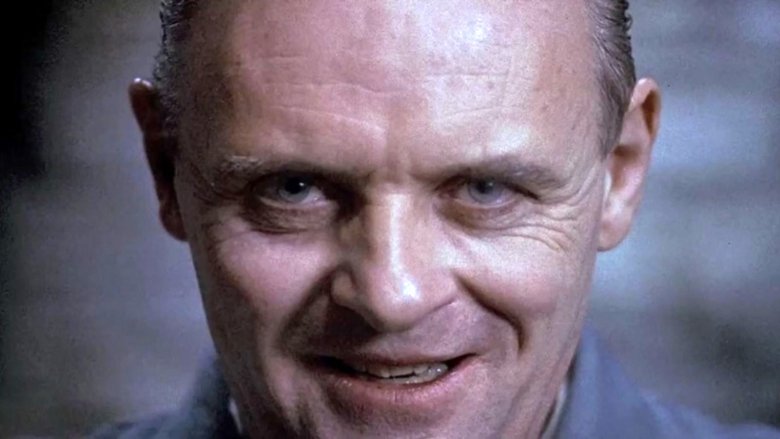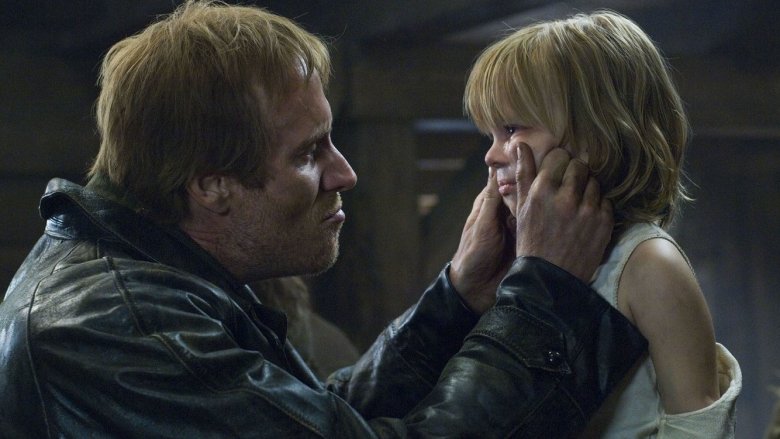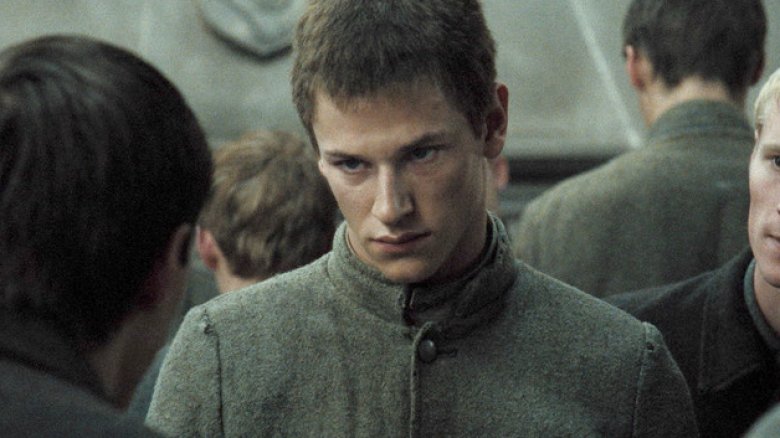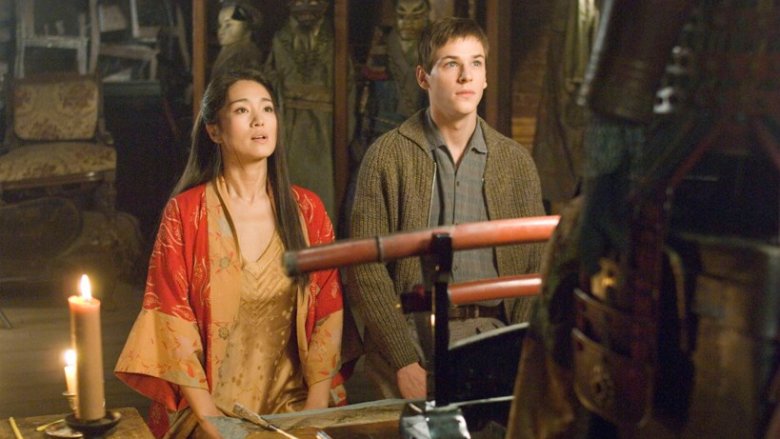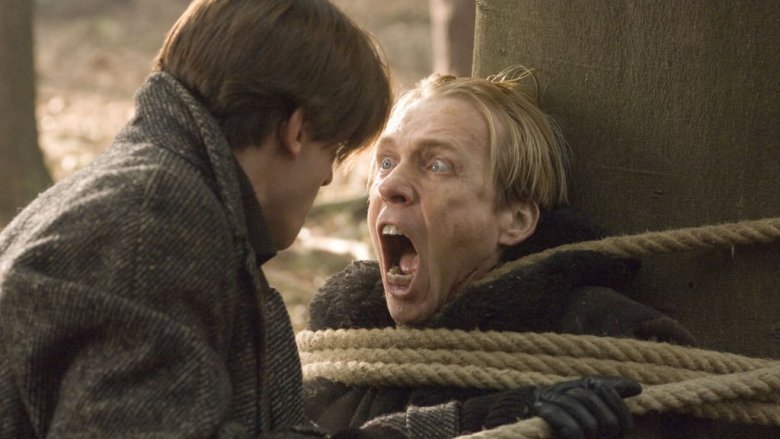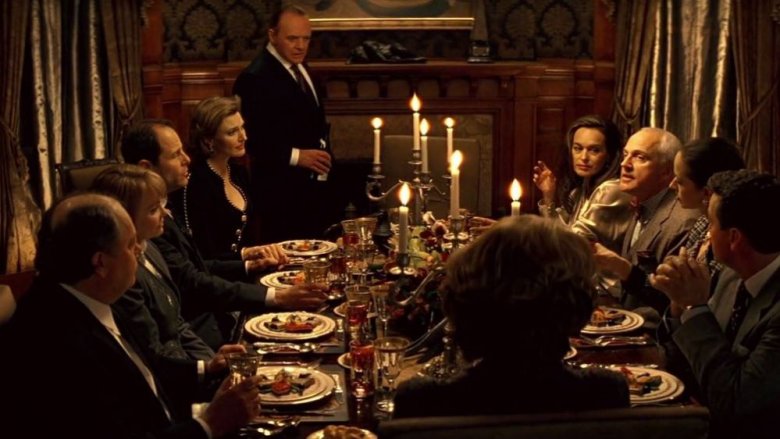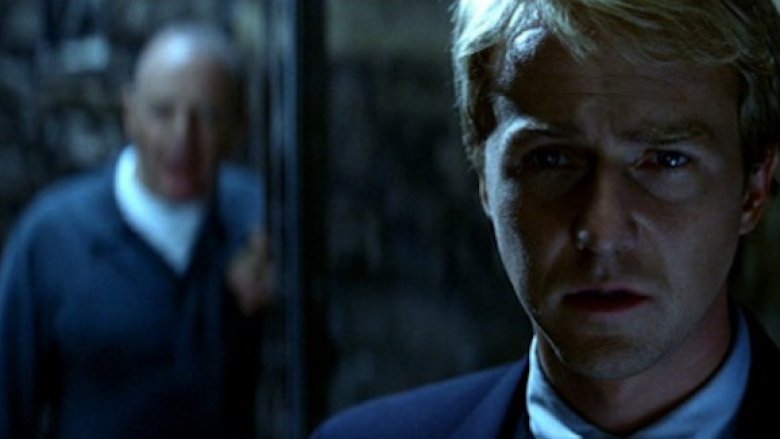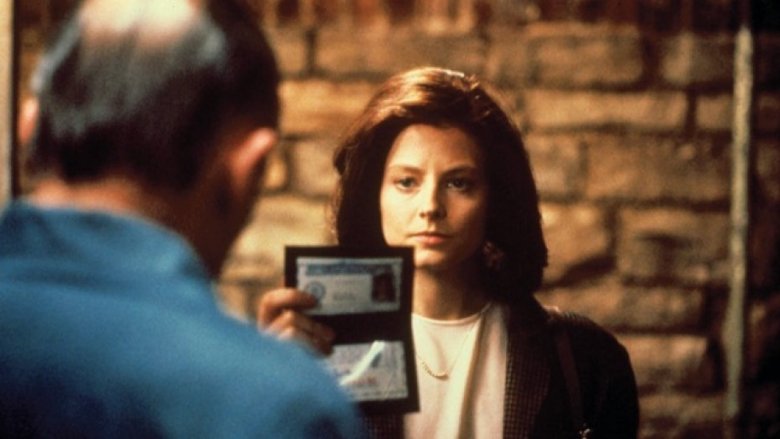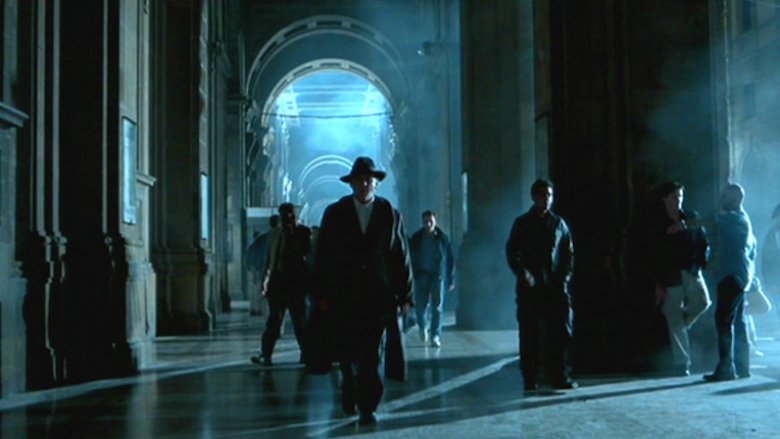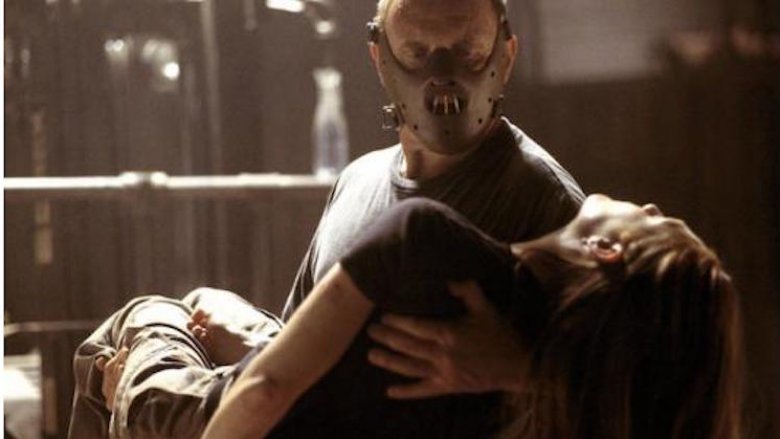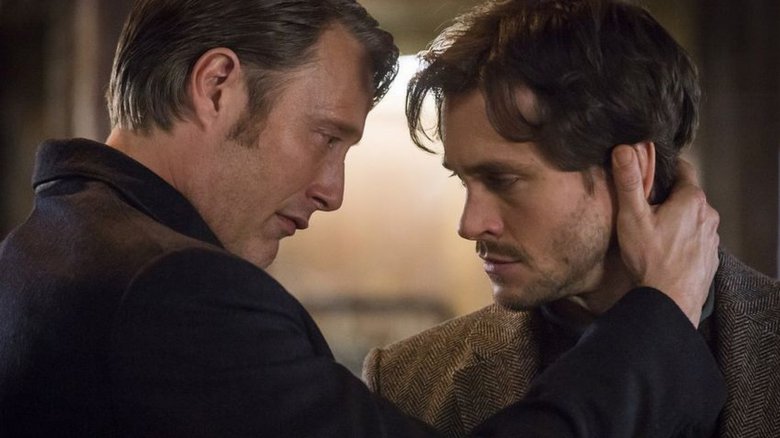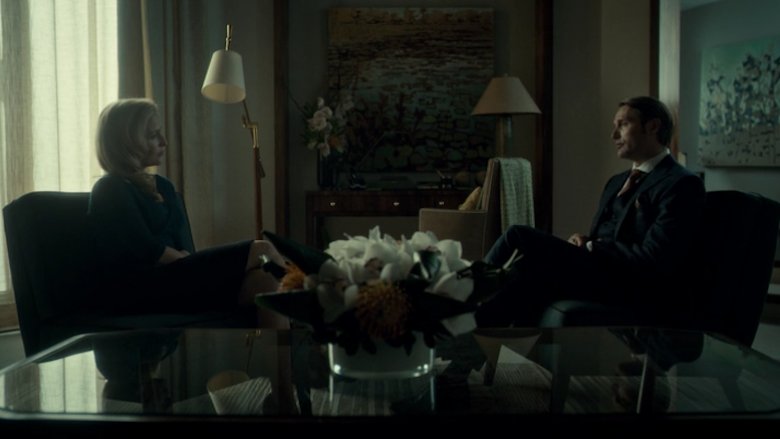Hannibal Lecter's Backstory Explained
Thomas Harris introduced audiences to Hannibal Lecter in his 1981 novel Red Dragon, in which the imprisoned psychiatrist/serial killer makes brief appearances to help FBI agent Will Graham find another serial killer. Hannibal's screen debut came in Manhunter, Michael Mann's 1986 adaptation of Red Dragon, starring a quietly menacing Brian Cox as Dr. Lecter and bringing the character to a much bigger audience.
But Hannibal Lecter didn't truly break through to worldwide infamy until Harris' 1988 novel The Silence of the Lambs, adapted into Jonathan Demme's Oscar-winning film in 1991. Played with cool panache by Anthony Hopkins, Hannibal Lecter became an instant fixture in the horror movie canon (and nightmares around the world). This refined serial killer and gourmand broke the mold. Lecter had inhuman control over his mind and body as well as an above-average sense of smell. He also seemed to kill almost without visible pathology, at least at first.
In 2006, Harris revealed Lecter's dark and tragic childhood in his prequel novel, Hannibal Rising. But what were the events and traumas that shaped Hannibal Lecter into the weirdly beloved serial killer he became? The fava beans are stewing and the Chianti is decanting — we're having lots of old friends for dinner to explore Hannibal Lecter's story.
Hannibal Lecter's foundational childhood tragedies
Hannibal Lecter was born on January 20, 1933 in the southeastern region of Lithuania to a family of great wealth and noble bloodline on both sides. His Lithuanian father, Count Lecter, was a direct descendent of Teutonic warlord Hannibal the Grim, and his Italian mother's ancestors ruled Milan for over two centuries. With such a refined and renowned family, Hannibal's education began early, and his teachers quickly discovered his prodigious intellect as well as a gift for learning languages. By the time he was 10 years old, Hannibal could speak Lithuanian, German, English, and Italian, and was on the road to being fluent in Latin. In 1939 his sister Mischa was born; Hannibal was extremely protective of her, and cared for her more than anyone else.
It wasn't long after Mischa's birth that the first tragedy befell Hannibal and his family. In 1941, Nazi troops invaded the Lecter castle, forcing the family to escape into their cabin hideaway in the woods. A small group of Nazis, lead by a brutish sadist named Vladis Grutas, found the Lecters and killed the parents in front of their children. Mischa and Hannibal were kidnapped and held prisoner in the cabin until they ran out of food. Grutas butchered Mischa and cooked her in a stew in front of Hannibal, who was fundamentally traumatized by being forced to eat her as well. Still in shackles, Hannibal managed to escape into the woods. He was only eight years old.
Hannibal returns to an unfamiliar Castle Lecter
By the grace of wartime alliances, young Hannibal was found by Soviet soldiers wandering in the woods. He suffered from hypothermia and dehydration, and the flesh under his shackles was infected. Hannibal had also become mute from the traumas he'd survived — though he'd fully repressed the memory of eating his sister's flesh. In the meantime, the Russians had occupied Castle Lecter, using it as an orphanage for children like Hannibal. He was back in his childhood home, but by then it was only a haunting echo of the place it used to be.
Because he was mute, his fellow orphans considered this a sign of weakness and the older kids bullied Hannibal mercilessly for it. They also bullied him about the sixth finger on his left hand. Hannibal took the abuse, but when he saw other and younger children being bullied as well, he started lashing out violently against the aggressors. The start of Hannibal Lecter's particular code later in life for choosing his victims began here, in particular targeting bullies with their own modes of violence. He was in many physical altercations, but had yet to kill.
Hannibal Lecter reconnects with family and kills for the first time
After Hannibal's 13th birthday, he discovered he still had living relatives when his uncle, Count Robert Lecter, arrived at the castle-turned-orphanage to adopt his nephew. Hannibal went to live with Uncle Robert and his wife, Lady Murasaki, in their country home in Essonne, France. Hannibal was still mute, but he had an instant connection with Lady Murasaki, who helped him begin to heal using martial arts, cooking, and meditation. Thanks to Lady Murasaki, Hannibal started developing a taste for the finer things in life, not just food and spirituality. He also started speaking again and added Japanese to his list of fluent languages.
But tragedy would befall young Hannibal once more after the local butcher insulted Lady Murasaki with racial and misogynistic slurs. As he did in the orphanage when faced with bullies, Hannibal attacked the butcher and in the resulting fracas, his Uncle Robert had a heart attack and died. In a haze of rage and grief, Lecter stalked and killed the butcher with one of Lady Murasaki's samurai swords, eventually cutting out his cheeks and eating them. This was Hannibal's first kill, and his first act of cannibalism by choice. Local law enforcement, headed by intuitive Inspector Popil, knew Hannibal killed the butcher — but since Hannibal passed a lie detector test with a convincing story, Popil was forced to let him go.
The Paris years and Hannibal Lecter's revenge
In the wake of Robert Lecter's tragic and untimely death, Hannibal and Lady Murasaki moved to Paris. Hannibal's exceptional intelligence landed him a spot in a highly esteemed boarding high school, where he focused on medicine and graduated with honors as the youngest person in the school's history. He also completed his diploma in record time.
At just 18 in 1951, Hannibal returned to the cabin where his family was murdered in Lithuania. He hadn't quite have a full taste for murder yet, but after he gave his sister's bones a proper burial and found the dog tags of the brutes who killed and ate her, something snapped. He went after each of the men with cold precision, removing their cheeks to eat them. Hannibal was newly on police radar when country policeman Inspector Popil returned, convinced that Hannibal was now a serial killer.
In retaliation for the killings, the Nazi ringleader Grutas kidnapped Lady Murasaki, who was almost murdered during Hannibal's rampage to avenge his sister's death. When Grutas reminded Hannibal that he also partook of his sister's cooked flesh, the repressed memory pushed Hannibal from methodical to crazed killer. The monster Lady Murasaki saw emerge from her beloved nephew-in-law frightened her so deeply she fled France and went into hiding, after which Hannibal let her go and never sought her out again. His (romantic) feelings for his aunt had become too complicated.
Hannibal Lecter's Baltimore years
While Hannibal was in jail awaiting trial for the murder of the Nazi Grutas and his minions — murders he was swiftly acquitted for due to public outcry in his support — he worked with the medical examiner Dr. Dumas sketching post-autopsy bodies. Thanks to these, Hannibal received an internship at Johns Hopkins in Baltimore that turned into university and post-graduate studies. Hannibal became a highly regarded psychiatrist with a reputation for throwing exquisite dinner parties — during which time he continued killing and cannibalizing, often feeding his unsuspecting guests choice morsels of his victims.
One of his patients, the millionaire Mason Verger, was a sadistic pedophile and rapist who was in treatment after his crimes had come to light. Another of Lecter's patients was Verger's sister Margot, who Mason had assaulted so badly she would never be able to have children. After finding out what Mason did to his younger sister, Hannibal drugged him with hallucinogenics and suggested Mason cut up and eat his own face, which he did. Hannibal meant to kill him, but Mason survived to be a paraplegic with a grudge for the rest of his life.
Around the same time, Dr. Lecter was helping Detective Will Graham with a serial killer case, The Chesapeake Ripper, which happened to be Lecter's own murders. When Graham discovered Lecter's true identity, they almost killed each other in the violent showdown.
Hannibal Lecter's prison years and Will Graham's return
Hannibal Lecter was convicted of multiple homicides and remanded to Baltimore State Hospital for the Criminally Insane without eligibility for parole. Hospital staff quickly found out Lecter was unlike any of the other psychopaths housed in their facility. He was a master of self-control, able to manipulate his body and vital functions with such precision as to fool machines. He also actively cultivated his "Memory Palace," detailed rooms in his mind filled with art, books, and places he hoped to see again in person. One day, he pretended to have a seizure and proceeded to kill a nurse, just because he could. This forced hospital administrator Fredrick Chilton to create entirely new protocols on how to handle Lecter, which included absolutely no physical contact. Hannibal's only ally was Barney, a compassionate orderly who became as friendly with Lecter as anyone could.
While Hannibal might have been one of the most disturbing serial killers ever caught, he was also still one of the psychiatric community's greatest minds, especially when it came to people like himself. In 1978, Will Graham came out of retirement to help the Baltimore PD with a series of brutal family murders taking place on a lunar cycle. Graham confronted his nemesis Lecter once more for help on the case, identifying the "Tooth Fairy" killer as Francis Dolarhyde, a film tech who was choosing targets through their home videos. After the case ended with Dolarhyde's death, Lecter continued to write Graham letters, claiming that Will was the only person in the world who truly knew him. There was a sad truth in it.
Clarice Starling and the screaming of the lambs
Hannibal Lecter would have no contact with anybody but Fredrick Chilton, Barney, and other orderlies for the next five years — until the FBI sent in Special Agent Clarice Starling to get Hannibal talking about a former patient who the FBI suspected might be "Buffalo Bill," the serial killer skinning and murdering women. Hannibal saw right through Clarice, but also found himself drawn to her. In a cruel game of "quid pro quo" he got her to reveal personal details about her life in exchange for information about Buffalo Bill, although only some of what Lecter told her turned out to be true.
Hannibal eventually revealed that a Baltimore Philharmonic flautist he'd killed, Benjamin Raspail, had been Buffalo Bill's lover — and Hannibal had treated them both. Hannibal toyed with Clarice while dropping clues that would help her find Buffalo Bill and save the woman he had imprisoned.
While Clarice was earning her FBI badge catching Buffalo Bill, Lecter staged an elaborate murder scene and escaped custody while wearing the face of a police officer monitoring him. He murdered several more people, this time out of necessity rather than desire, and ended up in the Bahamas where Fredrick Chilton happened to be vacationing. Hannibal called Clarice to tell her he wouldn't be seeking her out, saying "the world is more interesting with you in it," before hinting that he'd be "having an old friend for dinner." Fredrick Chilton was never seen or heard from again.
Hannibal Lecter's Florence years
Following his escape, Hannibal Lecter went through extensive plastic surgery on his face, only sparing his nose for fear he'd lose his extra-sensitive sense of smell. He started going by Dr. Fell and set up shop in Florence, where he rebranded himself as an art expert and museum curator — after murdering his predecessor, of course. Hannibal was of Italian heritage on his mother's side, so he also started investigating his bloodline along with his curatorial duties. But despite his efforts, he wasn't as incognito as he thought.
Hannibal's old "friend" Mason Verger had been stewing in his rage revenge juices for years, and put a multi-million dollar price tag on Lecter's whereabouts with an eye toward enacting an elaborate plan to feed his old nemesis alive to wild boars trained to eat human flesh. Detective Rinaldo Pazzi thought he had identified Lecter as Fell; instead of turning him in to the FBI or Interpol, Pazzi decided to try capturing him to claim the bounty. Instead, Lecter killed him.
In the meantime, a disgraced Clarice Starling — demoted after a botched heist — figured out the Mason Verger and Pazzi connection as well as Lecter's location. Clarice tried to save her career by finding Lecter first, but Hannibal kidnapped her. Margot Verger ended up killing her brother Mason, and Hannibal took the fall for it.
Hannibal Lecter and Clarice Starling on the run
Hannibal slowly came to accept the horrific trauma of having eaten his own dear sister Mischa and how that had shaped his subsequent crimes and desires. While he was sexually attracted to Clarice, he also saw his sister in her. Her anecdotes from their "quid pro quo" game all those years ago created a soft spot in Hannibal for Clarice, leaving oddly protective of her and wanting to keep her safe.
But even so, this didn't stop Hannibal from hurting Clarice. He attempted to drug and brainwash her into believing she really was Mischa so he could have a proxy of his sister back, but Clarice was too mentally strong, even for Lecter's considerable machinations, and she overpowered his attempts. During that process of hypnosis, though, Clarice was altered mentally, becoming a different kind of student of Hannibal Lecter's singular psychopathy. Clarice and Hannibal became romantically involved and were last spotted in Buenos Aires. By the end, it was unclear whether Clarice was with him because of his thrall or she'd actually chosen to align herself with the serial killer she once hunted.
Bryan Fuller's Hannibal television show diverts from source material and adds to Lecter's story
In 2013, showrunner Bryan Fuller created an arthouse version of Hannibal Lecter's story that drew heavily from the previous books and movies while simultaneously creating a new narrative. Played by Mads Mikkelsen, Fuller's Lecter was in his 40s, with a backstory that saw him going to Florence as a young man and starting his killing there. Inspired by "The Monster of Florence," Fuller drew from the real-life set of 16 ritualized murders that took place between 1968–1985 — and for which conspiracies still abound that the real killer remains at large.
Fuller's Hannibal was also the Baltimore PD's on-call psychiatrist for profiling purposes and didn't just work sporadically with the department. He acted as therapist to many of his colleagues, including Will Graham, with whom he had a deeply intense and complicated relationship that bordered on erotic.
This version of Hannibal is not only the Chesapeake Ripper, but often mimicked killings of the same murderers he'd been tasked to help catch, adding to their body counts. Lecter's martial arts training was also far more apparent in the television show than the books or movies. Also unlike other versions, Hannibal's three-season run offered a textbook manual on how to identify Hannibal's gaslighting practices along with his cannibalism, which was sometimes equally disturbing. Here, Hannibal even managed to frame Graham for a series of murders Hannibal himself committed — all the while convincing Graham that he actually did it.
Bryan Fuller's Hannibal adds new characters to flesh out his backstory
Bryan Fuller's Hannibal didn't just deepen the relationship between Will Graham and Hannibal, it also added a number of key characters who helped make the new iteration of Hannibal Lecter profoundly three-dimensional. Many of these characters appeared marginally in Thomas Harris' books, but Fuller gave them new life.
Chiyoh was Lady Murasaki's maid, and in this version she helped Hannibal find, torture, and imprison the men who killed his sister. A gender-flipped Dr. Alana Bloom, first mentioned in Red Dragon as Alan, became a pivotal figure torn between helping a troubled Will Graham and being actively gaslighted by her serial killer boyfriend Hannibal Lecter. Garrett Jacob Hobbs, the killer known as the Minnesota Shrike, and his daughter Abigail were also mentioned in Red Dragon, and played a much larger role in the television Hannibal's three-season arc. Another Red Dragon character, the relentless tabloid journalist Freddie Lounds, was also gender-flipped and survived. These characters each added multiple levels of text and subtext to Fuller's rich vision of Hannibal Lecter.
New characters include FBI Agent Miriam Lass, who discovered Hannibal's identity but disappeared before she could tell anyone. Lass was presumed dead after her severed hand was identified, but the audience later discover Hannibal had kept her alive for years in an underground bunker. Fuller's Hannibal also introduced audiences to his own therapist, Bedelia Du Maurier, who provided incredible insight into Hannibal's mind — as well as a sense of fear about who, or what, she suspected him to be.
